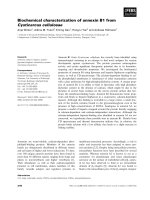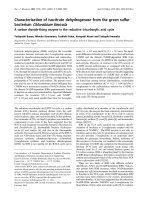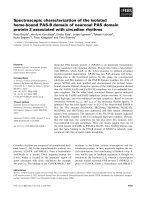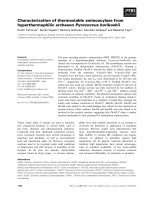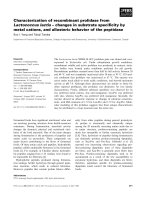characterization of bacteria isolated from silver pomfret (pampus argenteus euphrasen, 1788) cultured in nhatrang bay, vietnam
Bạn đang xem bản rút gọn của tài liệu. Xem và tải ngay bản đầy đủ của tài liệu tại đây (635.62 KB, 32 trang )
CAN THO UNIVERSITY
COLLEGE OF AQUACULTURE AND FISHERIES
CHARACTERIZATION OF BACTERIA ISOLATED FROM
SILVER POMFRET (Pampus argenteus Euphrasen, 1788)
CULTURED IN NHATRANG BAY, VIETNAM
By
NGUYEN NHUT THANH
A thesis submitted in partial fulfillment of the requirements for
the degree of Bachelor of Aquaculture
Supervisor
Ms. Tran Thi My Duyen
Assoc. Prof. Dr. Dang Thi Hoang Oanh
Can Tho, December 2013
CAN THO UNIVERSITY
COLLEGE OF AQUACULTURE AND FISHERIES
CHARACTERIZATION OF BACTERIA ISOLATED FROM
SILVER POMFRET (Pampus argenteus Euphrasen, 1788)
CULTURED IN NHATRANG BAY, VIETNAM
By
NGUYEN NHUT THANH
A thesis submitted in partial fulfillment of the requirements for
the degree of Bachelor of Aquaculture
Supervisor
Ms. Tran Thi My Duyen
Assoc. Prof. Dr. Dang Thi Hoang Oanh
Can Tho, December 2013
APPROVED BY SUPERVISOR
The thesis “Characterization of bacteria isolated from silver pomfret (Pampus argenteus
Euphrasen, 1788) cultured in Nhatrang bay, Vietnam” which edited and passed by the
committee, was defended by Nguyen Nhut Thanh in 27/12/2013.
Student sign Supervisor sign
Nguyen Nhut Thanh Ass. Prof. Dang Thi Hoang Oanh
i
ACKNOWLEDGEMENT
First of all, I would like to express my deep and sincere gratitude to my supervisor, Dr.
Dang Thi Hoang Oanh for her guidance throughout my degree program
Many thanks are also given to all other doctors, lecturer of the college of aquaculture and
fisheries, and especially to those of the department of aquatic biology and pathology for
providing me with great working and learning conditions.
I wish to thank all of my friends for helping me get through the difficult times, and for all
the emotional support and encouragement, especially Vo Le Thanh Truc, Nguyen Trong
Nghia, Au Thi Kim Ngoc, Bui Thi Diem My, Le Thanh Can.
Finally, I would like to give thank my academic adviser, Dr Duong Thuy Yen, for her
guiding and encouraged me, also my parents and all my family members for their love,
understanding and support me more than four years in university.
ii
ABSTRACT
The purpose of this study was to isolate and characterize bacterial isolates which were
recovered from diseased Silver pomfret cultured in Nha Trang Bay, Khanh Hoa province.
A total of eights diseased speciments which were collected in October, 2012. Diseased
fish displayed lethargic swimming, hemorrhagic on skin, tumor on the body and whitish
granules in internal organs. Bacterial isolates were examined for morphology, selected
biochemical characteristics as well as susceptibility to common used antibiotics in
aquaculture. These isolates were identified as Photobacterium damselae, Vibrio
parahaemolyticus, and Vibrio alginoticus, by using API 20E test kit. Result of antibiotic
sensitivity tests showed that these isolates were completely resistance with amoxycilline,
bicomarin, ampicillin; and they were all susceptible with norfloxacin, ciprofloxacin,
florenicol and tetracycline.
iii
TABLES OF CONTENTS
ACKNOWLEDGEMENT i
ABSTRACT ii
TABLES OF CONTENTS iii
LIST OF FIGURES v
LIST OF TABLES vi
CHAPTER 1 INTRODUCTION 1
1.1 Introduction 1
1.2 Research objective 2
1.3 Research activities 2
CHAPTER 2 LITERATURE REVIEW 3
2.1 Silver pomfret 3
2.2 Cause of diseases 3
2.3 Some common bacterial diseases in brackish and marine fishes 4
2.3.1 Vibriosis 4
2.3.2 Bacterial hemorrhagic septicaemia 5
2.3.3 Streptococcosis 5
2.4 Some commonly used antibiotics 6
2.4.1 Oxytetracycline 7
2.4.2 Ciprofloxacin 8
2.4.3 Florfenicol 8
CHAPTER 3 MATERIALS AND METHODS 9
3.1 Time and sites of study 9
3.2 Materials 9
3.3 Methods 9
3.3.1 Fish sampling 9
3.3.2 Bacterial isolation 10
3.3.3 Bacterial identification 10
3.3.4 Antimicrobial susceptibility testing 10
3.3.5 Data collection, calculation and analysis 11
CHAPTER 4 12
RESULT AND DISCUSSION 12
iv
4.1 Fish sampling and clinical signs 12
4.2 Bacterial identification 13
4.3 Antimicrobial susceptibility testing 15
CHAPTER 5 CONCLUSIONS AND RECOMMENDATION 17
5.1 Conclusions 17
5.2 Recommendation 17
REFERENCE 18
Appendix 1.Some biochemical tests used in bacterial identification 20
Appendix 2. API 20E kit results 22
Appendix 3. The diameters of inhibition zone of the antibiotic susceptible test 23
v
LIST OF FIGURES
Figure 4.1 Fish sampled
Figure 4.2 Internal of diseased fish
Figure 4.3 Gram staining, O/F test and bacterial colonies on NA
Figure 4.4 API 20E identification test result of Photobacterium damselae
Figure 4.5 API 20E identification test result of Vibrio parahaemolyticus
Figure 4.6 API 20E identification test result of Vibrio alginoticus
Figure 4.7 API 20E identification test result of Aeromonas hydrophyla
vi
LIST OF TABLES
Table 4.1 The percentages of distinct strains
Table 4.2 Susceptibility pattern of bacterial species
1
CHAPTER 1
INTRODUCTION
1.1 Introduction
With more than 3200 kilometers of coastline and large area of water surface, Vietnam has
great conditions to develop aquaculture (both fresh and marine aquaculture). In fact,
aquaculture in Vietnam is developing year by year, especially farmed stripped catfish
(Pangasianodon hypophthalmus) and penaeid shrimp (black tiger and white leg shrimp),
Vietnam was ranked the world’s third of aquaculture (FAO 2010). Besides, marine
aquaculture is contributed an important part for aquaculture with high value species such
as sea bass, cobia (Rachycentron Canadum), grouper (Serranidae), silver pomfret
(Pampus argenteus)… Silver pomfret is one of a new cultured species is Vietnam as it
has high nutrition contain and quality of flesh meat.
Silver pomfret is easy to find in Northern gulf and central southern of Vietnam, in the
past, people mainly catch silver pomfret in the wild. In recent years, people started to
culture silver pomfret in cages with intensive model. In this system, fish are stocked at
high density, usually over feeding. This can make the fish get stress and diseases,
especially this can lead to disease spread out easily on the sea to wild fish, or the others
cages. Bacterial diseases have been reported as one of the worst problems causing up to
100% mortality of cultured fishes (Bui Quang Te, 2008). This is the new specie, there is a
few research about silver pomfret are conducted on over the world.
Antibiotics are known as the useful treatment for the bacterial disease, but can make bad
result if not use at correct ways or dosage. Bacterial resistance often happens and cause
treatment failure. People prefer using higher dosages of antibiotics when the previous
dosages do not have effect; they hope to heal illness completely, but residues in flesh
product are not favorable to consumers. In addition, resistance characteristic could
readily and quickly spread out in bacterial populations (Kumarasamy et al., 2010). The
uncontrolled of using antibiotics can make the presence of antibiotic residues in fish meat
and fish products and this also lead to a disease which cause by resistance bacteria and
hard to treat.
Thus, this thesis “Characterization of bacteria isolated from silver pomfret
(Stromateoides argenteus Euphrasen, 1788) cultured in Nhatrang bay, Vietnam” is
carried out to provide more information about disease on this species.
2
1.2 Research objective
The aim of this research is to investigate the bacterial pathogen which are isolated from
silver pomfret (Pampus argenteus) in Nhatrang bay, then find out the antibiotic which is
susceptible to these bacteria.
1.3 Research activities
This thesis focuses on the following contents:
1. Classification to species level of bacteria that was isolated from silver pomfret.
2. Antibiotics susceptibility testing.
3
CHAPTER 2
LITERATURE REVIEW
2.1 Silver pomfret
Silver pomfret (Pampuss argenteus) is a valuable food fish with a wide geographical
distribution from East China Sea to Southest Asia, the India Ocean, Arabian Gulf and
the North Sea (Davis and Wheeler 1985). Silver pomfret is found in coastal water
from 5 to 100 meters depth, it has maximum size 80 centimeters but usually see at 30
centimeters (FAO). In the past, it was only caught on the sea, but in recent years, it is
stared being culture in cages. Cages are placed in clean area, with viscosity about 0.2-
0.6m/s. This is new species cultured in Vietnam, it has high economic value base on
its nutrition value, high flesh meat quality. There is not many research about this
species have been reported in Vietnam.
2.2 Cause of diseases
Aquatic organisms are sensitive with the diseases, because they exposure directly with
the water where they live. Diseases can be caused by an etiological (specific cause) or
a nonetiological (contributing cause) agent. Etiological agents can be classified as
either inanimate or animate. Inanimate etiological agents are factors without life of
their own and can originate within a host (endogenous) or outside of a host
(exogenous). Endogenous, inanimate factors are those associated with genetic and/or
metabolic disorders of the host. Exogenous, inanimate agents include trauma,
temperature shock, electrical shock, chemical toxicity, and dietary deficiencies. These
etiological agents may serve as sublethal stressors that predispose fish to infectious
disease. Animate etiologies are living communicable infectious agents, which include
viruses, bacteria, fungi, protozoa, helminthes and copepods (Plumb, 1999).
Nonetiological causes of disease are characterized as extrinsic (from outside the body)
or intrinsic (within the body). Extrinsic factors are usually associated with
environmental conditions or dietary problems, and intrinsic factors include age,
gender, heredity, and fish species. Both fish species and strain of fish are important
because all are not equally susceptible to a specific disease organism. Feed quality,
4
water quality factors, and water temperature extremes can be classified as either
etiological or nonetiological extrinsic factors and can contribute to infectious disease
(Plumb, 1999).
2.3 Some common bacterial diseases in brackish and marine fishes
Bacteria are one of the most important-causative agents causing adverse diseases to
fish. Most bacterial agents causing diseases to fish are Gram-negative; some of them
are Gram-positive. They are ubiquitous in the environment (sea, lakes, rivers, canals,
ponds…) and are considered as the primary pathogen or the opportunistic pathogen.
They are usually chronic, acute or subacute diseases. In some cases, bacterial diseases
can cause 100% of mortality (Bui Quang Te, 2006).
2.3.1 Vibriosis
Vibriosis, also known as salt-water furunculosis, boil-disease, or ulcer-disease (Austin
and Austin, 2007), is among the most prevalent fish diseases caused by bacteria of
genus Vibrio (Woo and Bruno, 1998).This type of disease is commonly considered
stress mediated with the predisposing factors of handling, moving from fresh to salt
water (Plumb and Hanson, 2011), high temperature, crowding, and organic pollution
(Noga, 2010).
Vibriosis has been reported on many fish species, including salmon, rainbow trout,
turbot, sea bass, sea bream, striped bass, cod, and eel (Actis et al., 1999 cited by
Toranzo, 2005).Within Vibrionaceae, the species causing the most economically
serious diseases in marine culture are Vibrio anguillarum, Vibrio ordalii, Vibrio
salmonicida, Vibrio vulnificus biotype 2 (Toranzo et al., 2004), and Vibrio harveyi
(FAO, 2006).V.anguillarumis the most common fish-pathogenic vibrio (Noga, 2010).
Infected fish may havered areas on body, skin ulcers, depression, exophthalmos,
corneal ulcers, and swollen abdomen (Noga, 2010).Vibriosis, as with other bacterial
septicaemias, can be controlled by maintaining good water quality, but where
outcreaks occur, treatment with an oral antibiotic is the only option (Woo and Brono,
1998)
5
2.3.2 Bacterial hemorrhagic septicaemia
Bacterial hemorrhagic septicaemia, also referred to as motile aeromonad infection, infectious
dropsy, red pest, reddisease, red sore, rubella, and others (Plumb and Hanson, 2011), has
been associated with several members of genus Aeromonas such as A. hydrophila,A. sobria,
A. caviae, and Pseudomonas sp.(FAO, 2006). Disease syndromes may include lethargy,
anorexia, irregular reddened skin ulcerations, reddened abdominal fluid, and pale gills
(Austin and Austin, 2007).
By far the most significant fish pathogen is A. hydrophila (Noga, 2010). A. hydrophila is
widely distributed in the aquatic environment (Roberts, 2012). This species is a
pathogenic species mainly to fresh water fish, and occasionally to marine fish (Austin
and Austin, 2007). They occur as Gram-negative, motile, straight rods (0.3-1.0 x 1.0-
3.5µm) (Roberts, 2012). This bacteria species showed resistant to many types of
antibiotics, including ampicillin, chloramphenicol, erythromycin, nitrofurentoin,
novobiocin, streptomycin, sulphonamides, tetracycline, oxytetracycline (Aoki, 1988;
De Paoplaet al., 1988, cited by Austin and Austin, 2007), but were very sensitive to
enrofloxacin (Brag and Todd, 1988, cited by Austin and Austin, 2007).
2.3.3 Streptococcosis
Streptococcosis is sometimes called “popeye” because exophthalmos (exophthalmia)
is very common. This disease can cause darkening, pale gill, reddened fluid and
organs in infected fish (Noga, 2010).Diverse host species have been reported with
streptococcus infection, including rainbow trout, tilapia, hybrid triped bass (Eldar et
al., 1994) and sea bass (Bromage et at., 1999; Creeper and Buller, 2006). Even
though, many species of Streptococcosis, including S. agalactiae, S. iniae, S.
dysqalactiae, S. dysgalactiae, S. pyogenes, S. parauberis, and S. equi, have been
reported from fish,S. iniaeand S. agalactiaeare the two that mostfrequently cause
serious disease in tilapia.
Streptococcus iniae are small, Gram-positive, facultative anaerobic cocci, appearing
in chains (Roberts, 2012). Although S.iniae can affect various freshwater and coastal
fish species (Austin and Austin, 2007), this bacterial species is more commonly
isolated from fresh-water fish such as rainbow trout and tilapias than from marine fish
such as flounders and sardines (Kusada and Salati, 1999, cited by Roberts, 2012).Fish
infected by this species often get damaged brain, exophthalmia, surface and internal.
6
More importantly, fish pathogen S.iniae can cause disease in human hemorrhaging
(Austin and Austin, 2007). This bacterial agent can be treated with fluoroquinolone
compound, enrofloxacin (Stoffregenet al., 1996, cited by Austin and Austin, 2007).
Besides, laboratory studies also showed the efficacy of oxytetracycline and
amoxicillin in controlling S.iniae (Darwishet al., 2002; Darwish and Ismaiel, 2003,
cited by Austin and Austin, 2007).
2.4 Some commonly used antibiotics
Antibiotics are known as the best treatment when fish get bacterial diseases. People
usually take over dosages for sure that they treat the disease completely; this is not
only wasting of money but also make opportunities for bacterial resistance. The
residual of antibiotic in fish (aquatic species) could affect to human health. The
antibiotics most frequently used in aquaculture to combat bacterial diseases include
oxytetracycline, florfenicol, sarafloxacin, and enrofloxacin (Roque et al., 2001; Soto-
Rodríguez et al., 2006). Globally, other antibiotics such as chlortetracycline,
quinolones, ciprofloxacin, norfloxacin, oxolinic acid, perfloxacin, sulfamethazine,
gentamicin, and tiamulin are used (Holmstrom et al., 2003).
Major antimicrobial drugs used in aquaculture
(Prescott et al., 2000)
Product
Route
Dose
(mg/kg fish/day)
Indication
Antibiotics
Beta-lactams
Ampicillin
Oral
50-80mg/kg, 10 days
Gram (-)
bacteria
Amoxicillin
Benzyl penicillin
(with streptomycin)
Aminoglycosides
Neomycin
Oral
50-80mg/kg, 10 days
Kanamycin
Bath
20mg/l
Tetracyclines
Tetracycline
Oral
50-80mg/kg, 10 days
Oxytetracycline
Doxycycline
Bath
20mg/l
Macrolides
Erythromycin
Oral
50-80mg/kg, 10 days
Bacterial
kidney
disease
Bath
20mg/l
7
Chloramphenicol
group
Florfenicol
Oral
50-80mg/kg, 10 days
Gram (-)
bacteria
Thiamphenicol
Bath
20mg/l
Synthetic Antimicrobial Agents
Sulfonamides
Sulfamethazine
Oral
200mg/kg, 10days
Sulfadimethoxine
Sulfaguanidine
Potentiated
sulfonamides
Trimethoprim/
sulfadiazine(1:5)
Oral
50mg/kg, 10days
Ormetoprim/
sulfadimethoxine
50mg/kg, 5days
Quinolones
Oxilinic acid
Oral
10-30mg/kg, 10days
Flumequine
Sarafloxcin
10mg/kg, 5days
Note: Only oxytetracycline and ormetoprim-sulfadiazine are approved for use with food
fish in the United Staes.
2.4.1 Oxytetracycline
Oxytetracycline is widely employed to treat bacterial infections in aquaculture farms,
such as vibriosis and furunculosis (Capone et al., 1996; Prescott et al., 2000; Reed et
al., 2006; Wang et al., 2004). It belongs to the tetracycline group, which exerts
antimicrobial action against both Gram (-) and (+) bacteria, ricksettsias,
mycoplasmas, and others (Gómez-Gil et al., 2001). Tetracyclines are produced by
Streptomyces spp., which possess determinants for resistance to this class of
antibiotics. Oxytetracycline is a bacteriostatic antibiotic that exerts its antimicrobial
effect against protein synthesis, by bonding directly to the S7 protein of the 30S
subunit of the bacterial ribosome, thereby impeding the bonding of aminoacyl-tRNA
(aminoacyl transfer RNA) to the A-site of the ribosome. This prevents the addition of
amino acids to the growing peptide chain (Chambers, 2004; Isidori et al., 2005; Jara,
2007). In order for oxytetracycline to interact with its target site, it needs to pass
through the external membrane via passive diffusion through the OmpF and OmpC
pores, and through the cytoplasm membrane via an energy dependent process (Jara,
2007).
8
2.4.2 Ciprofloxacin
Ciprofloxacin is the main metabolite of Enrofloxacin and is active against a broad
spectrum of aerobic Gram (-) bacteria, including enteric pathogens such as
Pseudomonas and Serratia marcescens. It is also active against Gram (+) pathogens,
even when these bacteria have developed resistance to other antibiotics, such as
penicillin (Wen et al., 2007). It is not active against anaerobic bacteria and may be
used occasionally, in combination with other antibacterial agents, for the treatment of
mycobacterial infections. The antibacterial effects of ciprofloxacin arise from its
inhibition of Topoisomerase IV and bacterial DNA gyrase, which act by cleaving the
DNA of the bacterial chromosome and rejoining the ends once a superhelix is formed
(Banerjee et al., 2007). When these enzymes are inhibited, bacterial cell
multiplication is interrupted.
2.4.3 Florfenicol
This fluorinated antibiotic, derived from thiamphenicol, is a potent and broadly acting
bacteriostatic agent. It is effective in the treatment of infections caused by Pasteurella
piscicida, Aeromonas salmonicida, Vibrio anguillarum, and Edwardsiella tarda. Its
chemicalstructure is very similar to that of chloramphenicol, and florfenicol is
effective against bacteria that have developed the ability to deactivate other drugs,
such as thiamphenicol and chloramphenicol. Pharmacokinetically, florfenicol use has
been reported among some species of fish such as Atlantic salmon (Salmo salar), in
which a bioavailability of more than 95% is present, exhibiting a good distribution
among all of the organs and tissues. Its halflife in fish is less than 15 h (Yanong &
Curtis, 2005). However, published information for shrimp is scarce, meaning that the
kinetic behavior of this compound among these crustaceans has not yet been
completely elucidated.
9
CHAPTER 3
MATERIALS AND METHODS
3.1 Time and sites of study
- Time: January to June, 2013.
- Locations: Fish were sampled at Nhatrang bay, Vietnam.
- Place for conducting experiments: Department of Aquatic Pathology, College of
Aquaculture and Fisheries, Cantho University.
3.2 Materials
The media, chemicals, antibiotics and consumables used for this study are listed below:
- Nutrient agar (NA)
- Tryotic soy agar (TSA).
- Crystal violet (color Index No.42555)
- Ammonium oxalate
- Iodine
- Potassium iodide
- Safranin (Color Index No.50240)
- Chemicals for biochemical tests: O/F, motility, Indole, Oxidase, Catalase…
- Antibiotics: enflorxacin (ENR/5g), florfenicol (FFC/30g,), amoxycilline
(25g), norfloxacin (5g), ciprofloxacin (30g), trim/sulfa (1:19) (25g),
tetracyline (30g), neomycin (30g), ampicilline (35g), doxycyline (30g).
3.3 Methods
3.3.1 Fish sampling
Silver pomfret samples are collected from culture cages in Nhatrang bay, Nhatrang.
Samples of 2-3 diseased fish are collected from each cage, then sampled on-cages. The
fish have some clinical sign such as infected with water fleas, tumor on the body, the
body cavity and internal organs are bleeding, internal organs has white spots. After that,
keep the samples to transport to the laboratory of the College of Aquaculture and
Fisheries, Cantho University for analysis.
10
3.3.2 Bacterial isolation
Fish samples were first put on clean trays for observing. They were disinfected with 70
0
alcohols, and then carefully dissected to avoid damaging internal organs, and reduce the
risk of contamination. Internal signs of fish were also observed and noted.
Bacterial samples from liver, kidney, spleen, and brain were inoculated on nutrient agar
plates (Merck) supplemented with 1.5% sodium chloride to acquire the salinity of 15‰
and incubated at 28
0
C. After 24 hours of incubation, bacterial growth was checked, and
representative bacterial colonies were sub-cultured for purity.
3.3.3 Bacterial identification
Pure culture of bacterial isolates after being obtained were used in primary tests,
including Gram staining, motility, oxidase, catalase, oxidative-fermentative, O/129 tests,
following the method of Frerichs and Millar (1993), and Buller (2004). Detailed
procedures for each specific test are shown in Appendix 3. Bacterial strains were fully
identified by using API 20E test kit, following the instruction of the suppliers.
3.3.4 Antimicrobial susceptibility testing
The susceptibility patterns of the identified isolates were made by using disk diffusion
method described in Clinical and Laboratory Standards Institute document M2-A09
(CLSI, 2006). Five strains of bacteria which are identified used for this experiment.
Incubating loops are used to take 1-2 colonies from pure culture, and put into bottle with
about 30ml sterile BHI to vortex at 200 rounds/minutes for 24 hours. Bacterial solution is
now transferred into 50ml falcon tube for centrifugation (4000 rounds/minute for 15
minutes). The upper solution part is eliminated, and bacteria are washed 2-3 times under
sterile saline solution.
After the final centrifugation, and elimination of the upper part, 25ml of saline solution is
added, and the solution is well mixed. The density of bacteria is determined, using
spectrophotometer (wavelength = 600nm). Bacterial solution is then diluted to the
approximate concentration of 1-2 x 10
8
colony-forming units (CFU)/ml.
The standardized bacterial suspension is evenly spread on the surface of the agar plates
with a cotton swab. The surface of the medium is let to dry for 3-5 minutes to allow for
the absorption of excess moisture.
Antibiotic disks are placed on the surface of the inoculated and dried plate with sterile
forceps, and lightly pressed down to ensure complete contact between the disk and the
11
agar surface. Position disks such that the minimum center-center distance is 24mm and
no closer than 10-15mm from the edge of the petri dish. A maximum of six disks may be
placed in a 9-cm petri dish and 12 disks on a 150mm plate.
The zones of inhibition are observed after 24 hours of incubation at 28
0
C. The zone of
inhibition is the point at which no growth is visible to the unaided eye. Compare the
diameter of the zone of inhibition of the test isolates with those in the chart of
interpretative standard for veterinary pathogen.
3.3.5 Data collection, calculation and analysis
Data was analysis by using Microsoft Excel 2007.
12
CHAPTER 4
RESULT AND DISCUSSION
4.1 Fish sampling and clinical signs
Fish were sampled at Nhatrang bay, in December 2012. From each cage, both fish with
normal external appearance and diseased fish with abnormal swimming, severe ulcers
and/or hemorrhage on skin were sampled (Figure 4.1). Some were strong infected with
water fleas.
A
B
Figure 4.1 Fish sampled
A. Severe tumor
B. Hemorrhage of body silver pomfret
13
The internal organs of healthy fish were showed normal display, while diseased fish were
having bleeding body cavity and internal organs, we could also observed white spots on
internal organs (Figure 4.2).
Figure 4.2 Internal of diseased fish, A. Hemorrhage of body cavity and internal organs.
B. White spot on internal organs
4.2 Bacterial identification
Bacteria were isolated from the sampled by using nutrient agar media until they were
pure. These bacteria were used for identification step. After undergoing some basic
biochemical test based on the principles of Cowan and Steels (Barrow & Feltham 1993)
and using API 20E system (Bio Merieux, France), 4 isolates were identified as four
species including Photobacterium damselae, Vibrio parahaemolyticus, and Vibrio
alginoticus. The percentage of identity are shown in table 4.1
Table 4.1 The percentages of distinct strains
Strains
Identity (%)
No. of strains
Photobacterium damselae
99.99
2
Vibrio parahaemolyticus
99.5
1
Vibrio alginoticus
93.4
1
Morphological, physiological and biochemical characteristics of those species are
indicated in table 4.1. The details are described as follows:
14
Figure 4.3 Gram staining, O/F test and bacterial colonies on NA
Photobacterium damselae
There are two strains were identified as Photobacterium damselae from silver pomfret,
the colonies size was 2-3 mm after 3 days of incubating on NA agar. The Gram-staining
gave negative results but positive in O/F test, catalase and oxydase test. And the results of
API 20E test are shown in figure 4.4
Figure 4.4 API 20E identification test result of Photobacterium damselae
Vibrio parahaemolyticus
With Vibrio parahaemolyticus, after 24 hours of incubating, we observed that the
colonies were circular, entire and low convex. The color was creamed on nutrient agar.
The surface of the colonies was smooth and shiny. The Gram-staining had negative
result, O/F test, catalase and oxydase test of this strain gave positive. The details of API
20E test are shown below
Figure 4.5 API 20E identification test result of Vibrio parahaemolyticus
CT 1-1G
CT2-2KU
15
Vibrio alginoticus
This is strain Vibrio, we observed that it has the same characteristics as V.
parahaemolyticus. A clear difference between the two biochemical species is found in the
ability of sucrose fermentation which is negative for V. parahaemolyticus while it is
positive for V. alginolyticus (Shinoda, 2011)
4.3 Antimicrobial susceptibility testing
All strains were tested for their susceptibility with twelve commonly used antibiotics in
aquaculture. From the table below, all strains of bacteria were complete resistance with
amoxycilline, ampicilline, and bicomarin. They all were very sensitive to norfloxacin,
ciprofloxacin, florenicol and tetracycline in which florenicol showed largest inhibition
zone. With trim/sulfa, it was only susceptible with photobacterium damselae, the
remaining strains were just intermediate inhibition. Photobacterium damselae was the
strains which had highest number of resistance antibiotics (6/12 antibiotics). The other
three had from three to four number of resistance antibiotic. Vibrio alginoticus was the
most sensitive species to antibiotics (7/12 antibiotics)
Table 4.2 Susceptibility pattern of bacterial species
Antibiotics
Photobacterium
damselae
Aeromonas
hydrophila
Vibrio
parahaemolyticus
Vibrio
alginoticus
Amoxycilline
R
R
R
R
Erythromycin
R
I
I
S
Norfloxacin
S
S
S
S
Ciprofloxacin
S
S
S
S
Bicomarin
R
R
R
R
Florfenicol
S
S
S
S
CT2-3KU
Figure 4.6 API 20E identification test result of Vibrio alginoticus
16
Trim/sulfa
R
I
I
I
Tetracyline
S
S
S
S
Neomycin
R
R
I
I
Ampicilline
R
R
R
R
Doxycyline
S
S
S
S
Enrofloxacine
I
S
S
S
Note: S – susceptible, R –Resistant, I–Intermediate
With these results of antibiotic susceptibility test, recommend the antibiotics should use
for treating the bacterial disease of silver pomfret such as florfenicol. Do not abuse the
antibiotics to avoid the antibiotics resistance of bacteria. Some antibiotics like
amoxycilline, Bicomarin, ampicillin should not use because of wasting of money. Also
considering about the withdraw time of the antibiotic when use. Enfrofloxacine had good
results, could be use for treating bacterial disease but it had been ban in aquaculture field.
